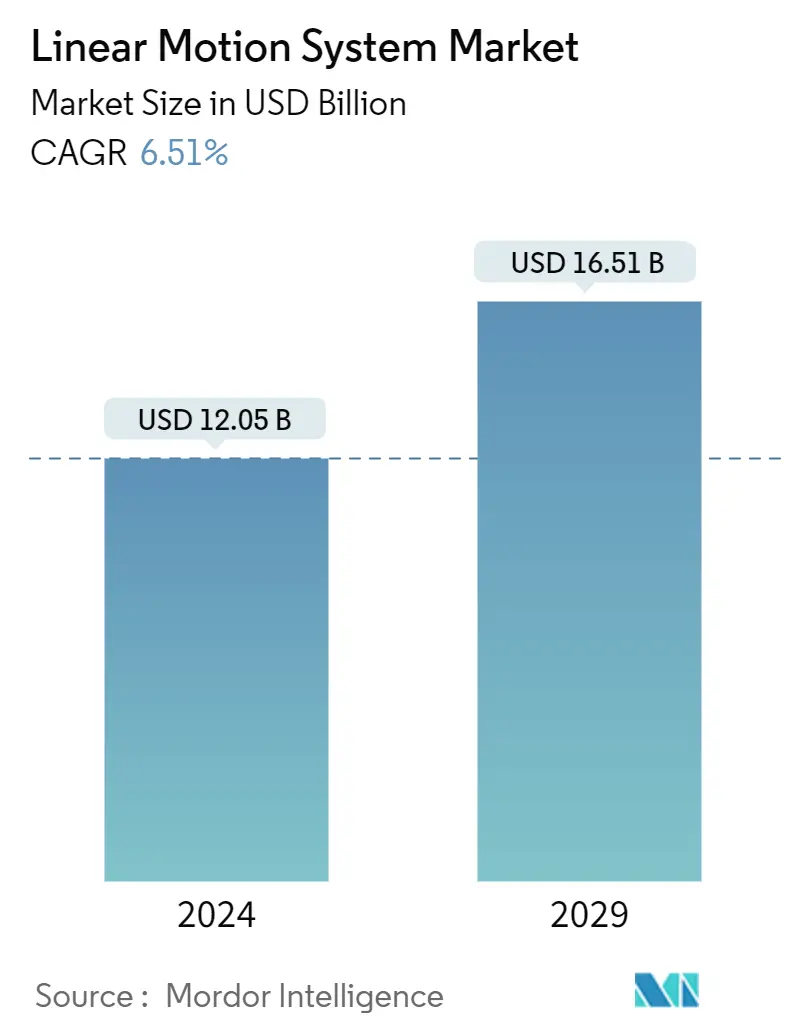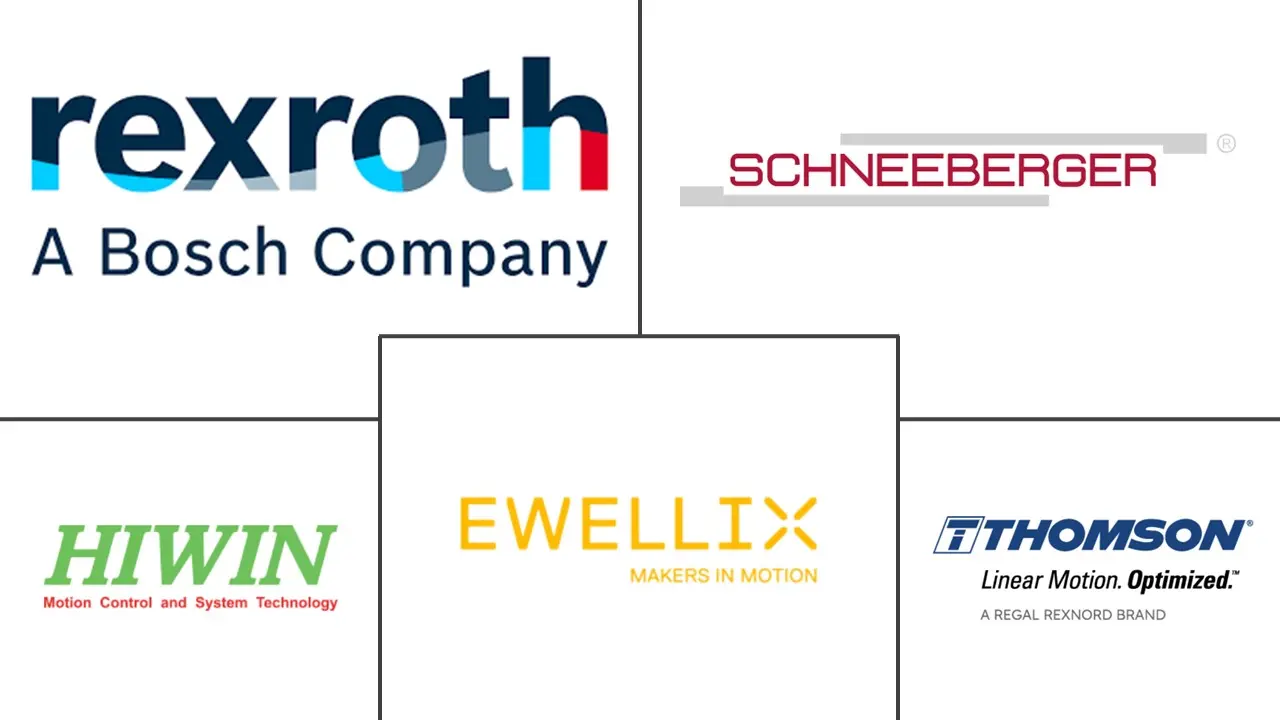Market Size of Linear Motion System Industry

| Study Period | 2019 - 2029 |
| Market Size (2024) | USD 12.05 Billion |
| Market Size (2029) | USD 16.51 Billion |
| CAGR (2024 - 2029) | 6.51 % |
| Fastest Growing Market | Asia Pacific |
| Largest Market | Asia Pacific |
Major Players
*Disclaimer: Major Players sorted in no particular order |
Linear Motion System Market Analysis
The Linear Motion System Market size is estimated at USD 12.05 billion in 2024, and is expected to reach USD 16.51 billion by 2029, growing at a CAGR of 6.51% during the forecast period (2024-2029).
- Linear motion systems provide a range of benefits, including smooth and reliable motion along a single plane, high positioning accuracies, and the ability to achieve high acceleration rates and long travel lengths with good thrust forces. Additionally, linear motion technology can increase production flexibility by allowing for quick and easy implementation in both existing and new systems.
- Further, the market is driven by many factors, including the shift in technology from hydraulic and pneumatic systems toward electromechanical systems to achieve higher precision, flexibility, reliability, and efficiency with less energy usage. These systems are in high demand due to their superior performance in extreme environmental conditions in industries. With reference to some industrial fields, such as packaging and automatic machines, the current trend is the transition from using hydraulic or pneumatic cylinders to electric linear actuators. The primary purpose is to have better control and greater versatility in automation and detailed customization of the machine or system in which the electric linear actuator is mounted.
- Linear motion systems have a diverse range of applications in manufacturing. They are used to provide precise and accurate positioning of equipment and products, making them suitable for use in automated manufacturing processes. These systems are used in packaging & palletizing, pick & place operations, material handling, precision machining, assembly & disassembly of products, inspection& quality control, die making, etc.
- Installation time is a significant challenge for the market. The high component count contributes to a longer and more complex installation process. All corresponding components need to be carefully and correctly positioned and secured for a proper motion to occur. For example, if the lead screw and linear guides are not parallel with one another in both axes, there is a high likelihood of binding occurring, causing the entire drive mechanism to stall out.
- The demand from industries like automotive, consumer electronics, and healthcare has increased in the post-pandemic situation, and this is anticipated to boost the demand for the market studied.
Linear Motion System Industry Segmentation
A linear motion system refers to a type of motion control system that enables objects to move in a straight line or along a fixed axis, typically in one dimension. It usually consists of a base or housing, a guide system that supports the frame or payload and ensures smooth movement, and a driving mechanism that powers the motion.
The linear motion system market is segmented by type (single-axis linear motion system, multi-axis linear motion system), end-user industry (automotive, electronics & semiconductor, manufacturing, aerospace, healthcare, and other end-user industries), and geography (North America, Europe, Asia-Pacific, Latin America, Middle East & Africa). The market sizes and forecasts are provided in terms of value in USD for all the segments.
| By Type | |
| Single-axis Linear Motion System | |
| Multi-axis Linear Motion System |
| By End-user Industry | |
| Automotive | |
| Electronics and Semiconductor | |
| Manufacturing | |
| Aerospace | |
| Healthcare | |
| Other End-user Industries |
| By Geography | |
| North America | |
| Europe | |
| Asia Pacific | |
| Latin America | |
| Middle East and Africa |
Linear Motion System Market Size Summary
The Linear Motion Systems Market is poised for significant growth, driven by the transition from traditional hydraulic and pneumatic systems to more advanced electromechanical systems. These systems offer enhanced precision, flexibility, and efficiency, making them increasingly popular across various industries. The demand for linear motion systems is particularly strong in sectors such as automotive, consumer electronics, and healthcare, where the need for automation and precise control is paramount. The market is characterized by a diverse range of applications, including packaging, material handling, and precision machining, which underscore the systems' versatility and reliability. However, challenges such as complex installation processes due to high component counts remain a consideration for market players.
In the electronics and semiconductor industries, linear motion systems are integral to manufacturing processes, supporting tasks like wafer handling and precision positioning. The miniaturization of components in these sectors further propels market growth, as smaller, more efficient systems are required for advanced manufacturing and inspection processes. The Asia-Pacific region is expected to witness substantial growth, fueled by industrial expansion and technological advancements, particularly in China and India. The automotive industry's shift towards automation and electrification also presents new opportunities for linear motion systems. The competitive landscape is moderately high, with key players like Bosch Rexroth AG, Schneeberger Group, and Ewellix AB leading innovations and expansions in the market.
Linear Motion System Market Size - Table of Contents
-
1. MARKET INSIGHTS
-
1.1 Market Overview
-
1.2 Industry Attractiveness - Porter's Five Forces Analysis
-
1.2.1 Bargaining Power of Suppliers
-
1.2.2 Bargaining Power of Buyers
-
1.2.3 Threat of New Entrants
-
1.2.4 Intensity of Competitive Rivalry
-
1.2.5 Threat of Substitutes
-
-
1.3 Industry Value Chain Analysis
-
1.4 An Assessment of the Impact of Key Macroeconomic Trends
-
1.5 Technology Snapshot
-
1.5.1 Power Components (Motors, Drives, and Controls)
-
1.5.2 Thrust Mechanism (Actuator)
-
1.5.3 Guidance Infrastructure (Linear Rail)
-
-
-
2. MARKET SEGMENTATION
-
2.1 By Type
-
2.1.1 Single-axis Linear Motion System
-
2.1.2 Multi-axis Linear Motion System
-
-
2.2 By End-user Industry
-
2.2.1 Automotive
-
2.2.2 Electronics and Semiconductor
-
2.2.3 Manufacturing
-
2.2.4 Aerospace
-
2.2.5 Healthcare
-
2.2.6 Other End-user Industries
-
-
2.3 By Geography
-
2.3.1 North America
-
2.3.2 Europe
-
2.3.3 Asia Pacific
-
2.3.4 Latin America
-
2.3.5 Middle East and Africa
-
-
Linear Motion System Market Size FAQs
How big is the Linear Motion System Market?
The Linear Motion System Market size is expected to reach USD 12.05 billion in 2024 and grow at a CAGR of 6.51% to reach USD 16.51 billion by 2029.
What is the current Linear Motion System Market size?
In 2024, the Linear Motion System Market size is expected to reach USD 12.05 billion.

